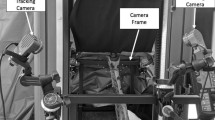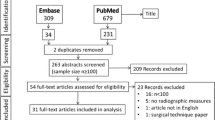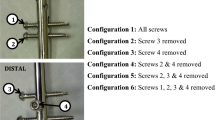Abstract
Purpose
Interfragmentary strain influences whether a fracture will undergo direct and indirect fracture healing. Orthopedic trauma surgeons modulate strain and create optimal biomechanical environments for specific fracture patterns using fixation constructs. However, objective intraoperative interfragmentary strain measurement does not currently inform fixation strategy in common practice. This review identifies potential methods and technologies to enable intraoperative strain measurement for guiding optimal fracture fixation strategies.
Methods
PubMed, Scopus, and Web of Science were methodologically queried for manuscripts containing terms related to “bone fracture,” “strain,” “measurement,” and “intraoperative.” Manuscripts were systematically screened for relevance and adjudicated by three reviewers. Relevant articles describing methods to measure interfragmentary strain intraoperatively were summarized.
Results
After removing duplicates, 1404 records were screened initially. There were 49 manuscripts meeting criteria for in-depth review. Of these, four reports were included in this study that described methods applicable to measuring interfragmentary strain intraoperatively. Two of these reports described a method using instrumented staples, one described optical tracking of Kirschner wires, and one described using a digital linear variable displacement transducer with a custom external fixator.
Conclusion
The four reports identified by this review describe potential methods to quantify interfragmentary strain after fixation. However, further studies are needed to confirm the precision and accuracy of these measurements across a range of fractures and fixation methods. Additionally, described methods require the insertion and likely removal of additional implants into the bone. Ideally, innovations that measure interfragmentary strain intraoperatively would provide dynamic biomechanical feedback for the surgeon to proactively modulate construct stability.


Similar content being viewed by others
References
Marsell R, Einhorn TA (2011) The biology of fracture healing. Injury 42:551–555. https://doi.org/10.1016/j.injury.2011.03.031
Wongchai B (2014) Study of the interfragmentary strain and the interfragmentary modulus with changing the distance between plate and femur. Am J Appl Sci 11:356–361. https://doi.org/10.3844/ajassp.2014.356.361
Shapiro F (1988) Cortical bone repair. The relationship of the lacunar-canalicular system and intercellular gap junctions to the repair process. J Bone Joint Surg Am 70:1067–1081
Hak DJ, Toker S, Yi C, Toreson J (2010) The influence of fracture fixation biomechanics on fracture healing. Orthopedics 33:752–755. https://doi.org/10.3928/01477447-20100826-20
Foster AL, Moriarty TF, Zalavras C et al (2021) The influence of biomechanical stability on bone healing and fracture-related infection: the legacy of Stephan Perren. Injury 52:43–52. https://doi.org/10.1016/j.injury.2020.06.044
Perren SM (2002) Evolution of the internal fixation of long bone fractures. The scientific basis of biological internal fixation: choosing a new balance between stability and biology. J Bone Joint Surg Br 84:1093–1110. https://doi.org/10.1302/0301-620x.84b8.13752
Cheal EJ, Mansmann KA, DiGioia AM et al (1991) Role of interfragmentary strain in fracture healing: ovine model of a healing osteotomy. J Orthop Res 9:131–142. https://doi.org/10.1002/jor.1100090116
Claes LE, Heigele CA (1999) Magnitudes of local stress and strain along bony surfaces predict the course and type of fracture healing. J Biomech 32:255–266. https://doi.org/10.1016/s0021-9290(98)00153-5
Hente RW, Perren SM (2021) Tissue deformation controlling fracture healing. J Biomech 125:110576. https://doi.org/10.1016/j.jbiomech.2021.110576
Claes L, Augat P, Suger G, Wilke HJ (1997) Influence of size and stability of the osteotomy gap on the success of fracture healing. J Orthop Res 15:577–584. https://doi.org/10.1002/jor.1100150414
Miramini S, Zhang L, Richardson M et al (2016) The relationship between interfragmentary movement and cell differentiation in early fracture healing under locking plate fixation. Australas Phys Eng Sci Med 39:123–133. https://doi.org/10.1007/s13246-015-0407-9
Burny F, Donkerwolcke M, Bourgois R et al (1984) Twenty years experience in fracture healing measurement with strain gauges. Orthopedics 7:1823–1826. https://doi.org/10.3928/0147-7447-19841201-08
Grasa J, Gómez-Benito MJ, González-Torres LA et al (2010) Monitoring in vivo load transmission through an external fixator. Ann Biomed Eng 38:605–612. https://doi.org/10.1007/s10439-009-9889-5
Kristiansen B, Borgwardt A (1992) Fracture healing monitored with strain gauges. External fixation of 7 humeral neck fractures. Acta Orthop Scand 63:612–614. https://doi.org/10.1080/17453679209169719
Nishimura N (1984) Serial strain gauge measurement of bone healing in hoffmann® external fixation. Orthopedics 7:677–684. https://doi.org/10.3928/0147-7447-19840401-21
Cunningham JL, Evans M, Kenwright J (1989) Measurement of fracture movement in patients treated with unilateral external skeletal fixation. J Biomed Eng 11:118–122. https://doi.org/10.1016/0141-5425(89)90120-9
Ogrodnik PJ, Moorcroft CI, Thomas PB (2001) A fracture movement monitoring system to aid in the assessment of fracture healing in humans. Proc Inst Mech Eng H 215:405–414. https://doi.org/10.1243/0954411011535984
Jenkins P, Nokes L (1994) The use of strain gauges to measurebone fracture healing—a review. Curr Orthop 8:116–118. https://doi.org/10.1016/S0268-0890(05)80065-9
Al Nazer R, Lanovaz J, Kawalilak C et al (2012) Direct in vivo strain measurements in human bone-a systematic literature review. J Biomech 45:27–40. https://doi.org/10.1016/j.jbiomech.2011.08.004
Roriz P, Carvalho L, Frazão O et al (2014) From conventional sensors to fibre optic sensors for strain and force measurements in biomechanics applications: a review. J Biomech 47:1251–1261. https://doi.org/10.1016/j.jbiomech.2014.01.054
Page MJ, McKenzie JE, Bossuyt PM et al (2021) The PRISMA 2020 statement: an updated guideline for reporting systematic reviews. BMJ 372:n71. https://doi.org/10.1136/bmj.n71
Gattiker F, Umbrecht F, Neuenschwander J et al (2008) Novel ultrasound read-out for a wireless implantable passive strain sensor (WIPSS). Sens Actuators, A 145–146:291–298. https://doi.org/10.1016/j.sna.2007.09.003
Greve DW, Oppenheim IJ, Chen AF (2012) An instrumented intramedullary implant to monitor strain in fracture healing. In: 2012 IEEE international Ultrasonics symposium. IEEE, p 1220–1223
Nabhani F, Bradley EJ, Hodgson S (2010) Comparison of two tools for the measurement of interfragmentary movement in femoral neck fractures stabilised by cannulated screws. Robot Comput Integr Manuf 26:610–615. https://doi.org/10.1016/j.rcim.2010.06.014
Buttermann GR, Janevic JT, Lewis JL et al (1994) Description and application of instrumented staples for measuring in vivo bone strain. J Biomech 27:1087–1094. https://doi.org/10.1016/0021-9290(94)90225-9
Ekenman I, Halvorsen K, Westblad P et al (1998) The reliability and validity of an instrumented staple system for in vivo measurement of local bone deformation. An in vitro study. Scand J Med Sci Sports 8:172–176. https://doi.org/10.1111/j.1600-0838.1998.tb00188.x
Kaspar K, Schell H, Seebeck P et al (2005) Angle stable locking reduces interfragmentary movements and promotes healing after unreamed nailing. Study of a displaced osteotomy model in sheep tibiae. J Bone Joint Surg Am 87:2028–2037. https://doi.org/10.2106/JBJS.D.02268
Funding
No funds, grants, or other support was received.
Author information
Authors and Affiliations
Contributions
JH, AR, and MDB contributed to methodology; AR, JH, and MDB contributed to formal analysis and investigation; AR contributed to writing-original draft preparation; AR, JH, MB, AP, SC, and CP contributed to writing—review and editing; and MDB contributed to supervision.
Corresponding author
Ethics declarations
Conflict of interest
The authors have no relevant financial or nonfinancial interests to disclose.
Consent to participate
The authors declare that this work complies with all the laws of the country in which it was performed.
Ethical approval
This is a narrative, literature review study deemed exempt by the Duke University IRB.
Informed consent
This review study of previously published literature did not involve any participants and therefore did not require any consenting.
Additional information
Publisher's Note
Springer Nature remains neutral with regard to jurisdictional claims in published maps and institutional affiliations.
Supplementary Information
Below is the link to the electronic supplementary material.
Rights and permissions
Springer Nature or its licensor (e.g. a society or other partner) holds exclusive rights to this article under a publishing agreement with the author(s) or other rightsholder(s); author self-archiving of the accepted manuscript version of this article is solely governed by the terms of such publishing agreement and applicable law.
About this article
Cite this article
Rechenmacher, A.J., Helmkamp, J., Brown, M. et al. Interfragmentary strain measurement post-fixation to guide intraoperative decision making: a narrative review. Eur J Orthop Surg Traumatol 33, 3299–3305 (2023). https://doi.org/10.1007/s00590-023-03605-y
Received:
Accepted:
Published:
Issue Date:
DOI: https://doi.org/10.1007/s00590-023-03605-y




